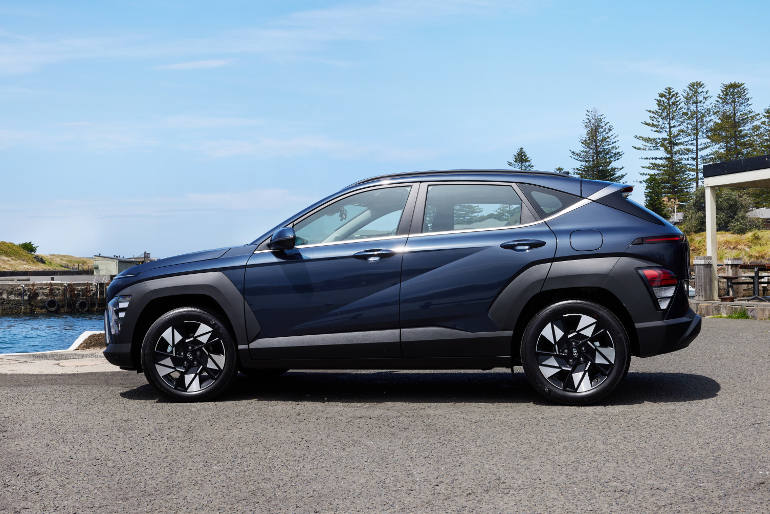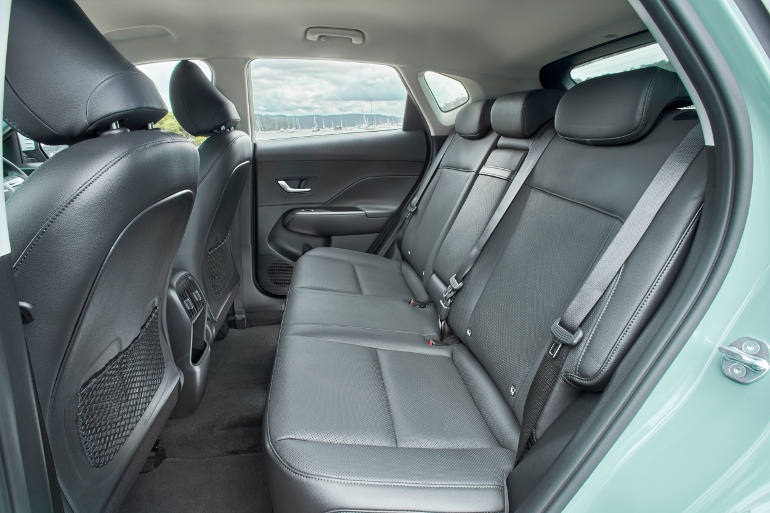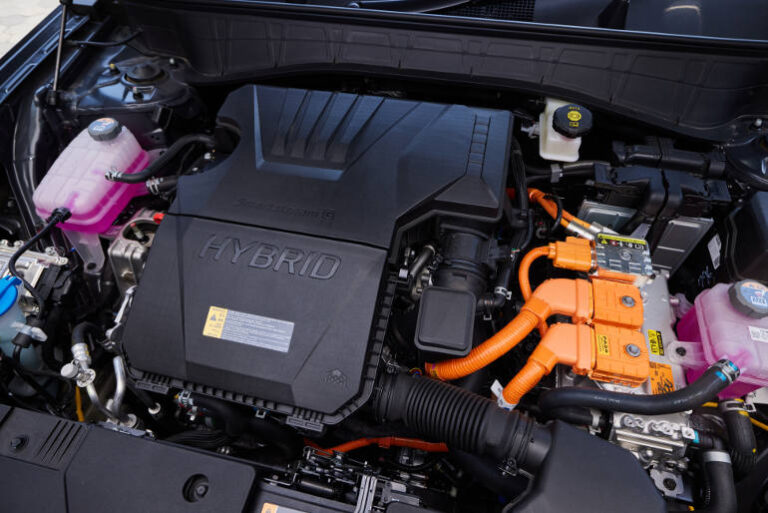The second-generation Hyundai Kona is primed to be an even more popular fleet choice than the previous version, thanks in no small part to the addition of a new hybrid option.
While the hybrid electric model costs $4,000 more than the equivalent-spec Kona petrol, it offsets this with 40 to 50% greater fuel economy, making it attractive on a total cost of ownership basis. In fact, a no-brainer for those not ready to go full EV.
It pairs a naturally aspirated 1.6-litre petrol engine with an electric motor and a lithium-ion battery recharged by regenerative braking, all driving the front wheels. Being a regular hybrid, there’s no plug required, just a 38 litre fuel tank to refill promising a range nudging 1,000km.
Hyundai claims fuel efficiency of just 3.9 litres per 100km even using 91 RON fuel on the both the urban and combined driving cycles (ADR), and CO2 emissions as low as 89 grams per 100km. It’s worth noting that I averaged around 5L/100km on my test, which is still sharp. With effort I reckon you could do better.

For urban driving in particular, the hybrid is a great option. The electric motor gets the car rolling before the petrol engine kicks in, making it smooth off the mark and particularly economical in stop-start urban driving, and offers a virtual engine sound a bit like an EV so you don’t spook pedestrians.
Peak power is 104kW and maximum torque is 265Nm, or about 50% more than the non-hybrid Kona. It’s acceptably brisk on the go thanks in part to having a dual-clutch automatic transmission, rather than a CVT like a Toyota hybrid, and it has an unchanged 1,300kg tow rating.
It’s quite good to drive too, getting the same rear multi-link independent suspension as the Kona AWD turbo, with well-weighted steering and good body control in corners courtesy of clever torque-vectoring, plus decent ride comfort on standard 18-inch wheels, and enhanced NVH suppression due to added sound-deadening.

The interior is a massive improvement on the model, in terms of design and in terms of space. It edges closer towards the bigger Tucson in terms of practicality, with more adult-friendly back seats and a more usable boot than the pokey old model.
This new Kona is bigger and more practical than the outgoing car, unsurprisingly. It’s 145mm longer, with more rear legroom and shoulder room, and a deeper, wider boot with 407-litre capacity (up 33L) with the back seats in use.
Hyundai’s design team clearly made usability a key focus inside, and the Kona is all the better for it. There are a number of buttons, dials and rocker switches to control the climate and multimedia, which in today’s screen-heavy age is a real win from a user interface perspective.
The use of padding on touchpoints and trim inserts that resemble brushed aluminium also liven things up. Even the base model feels a bit classy, and certainly not cheap-and-cheerful.
It’s quite practical too. Note the quirky shift-by-wire gear stalk on the steering column, with an end that you twist to select Drive or Reverse. This liberates added storage along the centre tunnel, which is great news for those who hoard a lot of stuff in their ride.
Also situated behind the wheel area paddles to control brake-energy recuperation levels, giving the hybrid a bit of an EV-like feel.
The 12.3-inch centre touchscreen is standard on all grades and offers wireless phone mirroring. It’s a slick setup that processes inputs rapidly and has excellent HD clarity, conversational voice controls, and remote app compatibility. The multimedia system is also capable of handling over-the-air updates via its SIM through the cloud, meaning the system should stay cutting-edge for longer and help residuals.
Those back seats offer greater head, shoulder and knee room than before meaning you don’t need to fret about carrying four adult passengers, while amenities such as rear vents, USB ports and cupholders are standard. The flagship variant even adds heated rear seats.
The boot is 172mm longer and 187mm taller than the old model’s, with capacity gains of 33L with the back seats in use (407L total) and 85L with the back seats folded (1241L). For a little context the new Kona’s boot is bigger than the i30’s, and three-quarters the size of the Tucson’s.

In terms of safety, we’re still waiting for the important ANCAP rating**. But it certainly comes well-specified, with standard fare including seven airbags (front-centre included), automated emergency call function, autonomous emergency braking with junction assist, blind-spot monitoring, adaptive cruise control, active lane-keeping assist, and rear cross-traffic alert.
It also comes with Hyundai’s controversial Intelligent Speed Limit Assist function which starts beeping any time you accidentally creep over the limit, to our slight annoyance. A new shortcut button on the wheel takes you to the screen menu to disable it, but it requires some menu digging and always reverts to ‘on’.
In terms of the specification walk, the base Kona comes with the following standard features:
- 18-inch wheels with a space-saver spare
- LED headlights and tail lights
- Parking sensors front and rear, rear camera
- Heated and power-folding side mirrors
- Smart key with remote and button start
- 4.2-inch instrument display
- 12.3-inch centre touchscreen with OTA updates
- Apple CarPlay, Android Auto and AM/FM/DAB+
- 4 x USB-C ports and a wireless phone charger
- Fabric seats with manual adjustments
- Dual-zone climate control with rear vents
The Kona Premium adds features such as:
- Surround-view parking cameras
- 12.3-inch instruments with blind-spot view camera
- Remote smart parking aid
- Rain-sensing wipers
- Sunroof (optional for $1,500)
- Privacy glass and power tailgate
- Satellite-navigation with live updates
- Eight-speaker audio upgrade (BOSE)
- Leather trim with heated and ventilated seats
For those keen on a sportier and edgier design, buyers can opt for the N Line options package which adds a body kit, different wheels, leather and Alcantara trims, and other sporty interior trims finished in red or alloy. This pack additionally unlocks brasher colour choices such as Neoteric Yellow and Soultronic Orange.
In terms of ownership, all Hyundais come with a five-year and unlimited kilometre warranty and a lifetime service plan, with the first five dealer services (intervals of 15,000km or 12 months) each capped at $399 for both the hybrid and regular petrol models.
2023 Hyundai Kona Hybrid pricing before on-road costs
- Kona hybrid: $36,000
- Kona hybrid + N Line pack: $40,000
- Kona Premium hybrid: $43,500
- Kona Premium hybrid + N Line pack: $46,500
- Sunroof option: $1500 (Premium only)
- Metallic or mica premium paint: $595
With more interior space than before, some segment-leading interior technologies, and a fuel-sipping hybrid option, the new Kona stacks up as a great option against rivals such as the Mazda CX-30, Mitsubishi ASX, MG SZT, Toyota Corolla Cross, Subaru XV, and all the rest.
And with the evergreen i30 hatch about to enter a hiatus while Hyundai Australia switches to European sourcing, expect its fleet team to push the new Kona harder than ever before.







